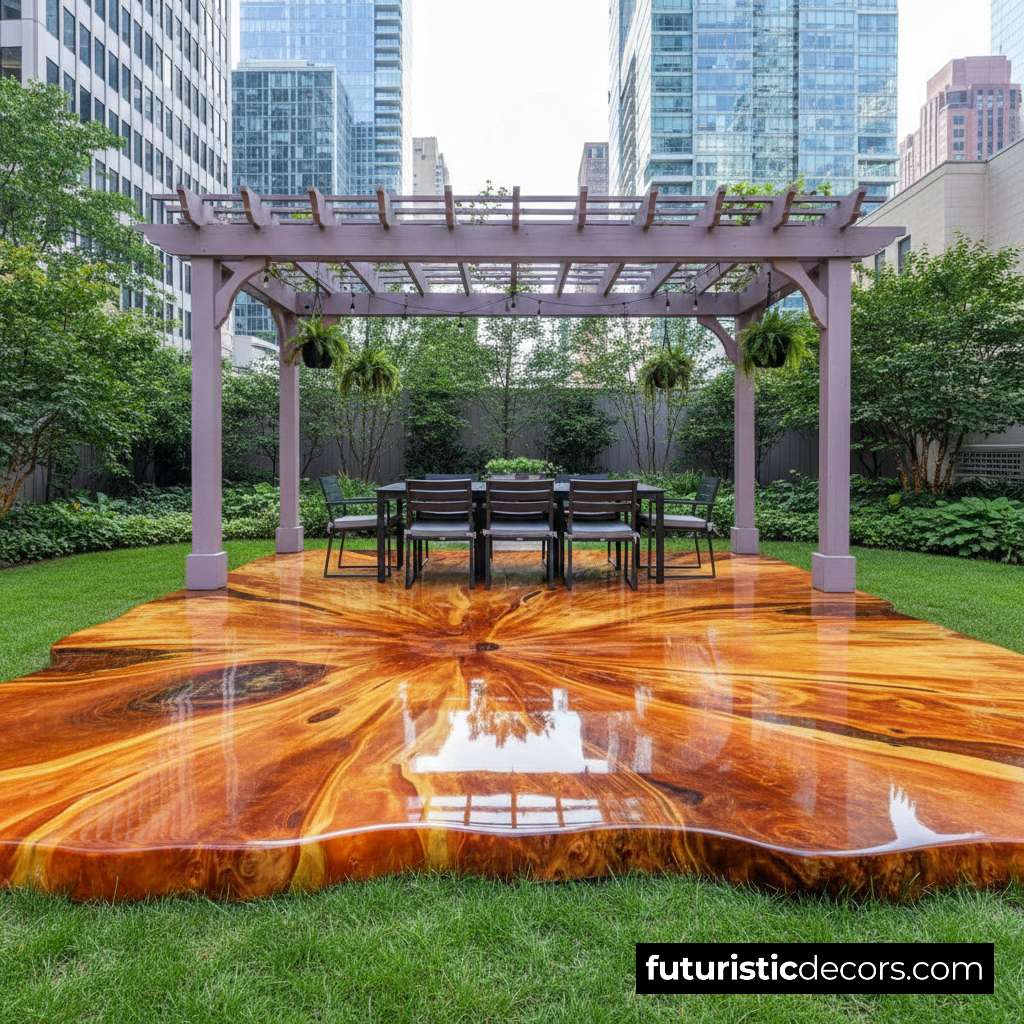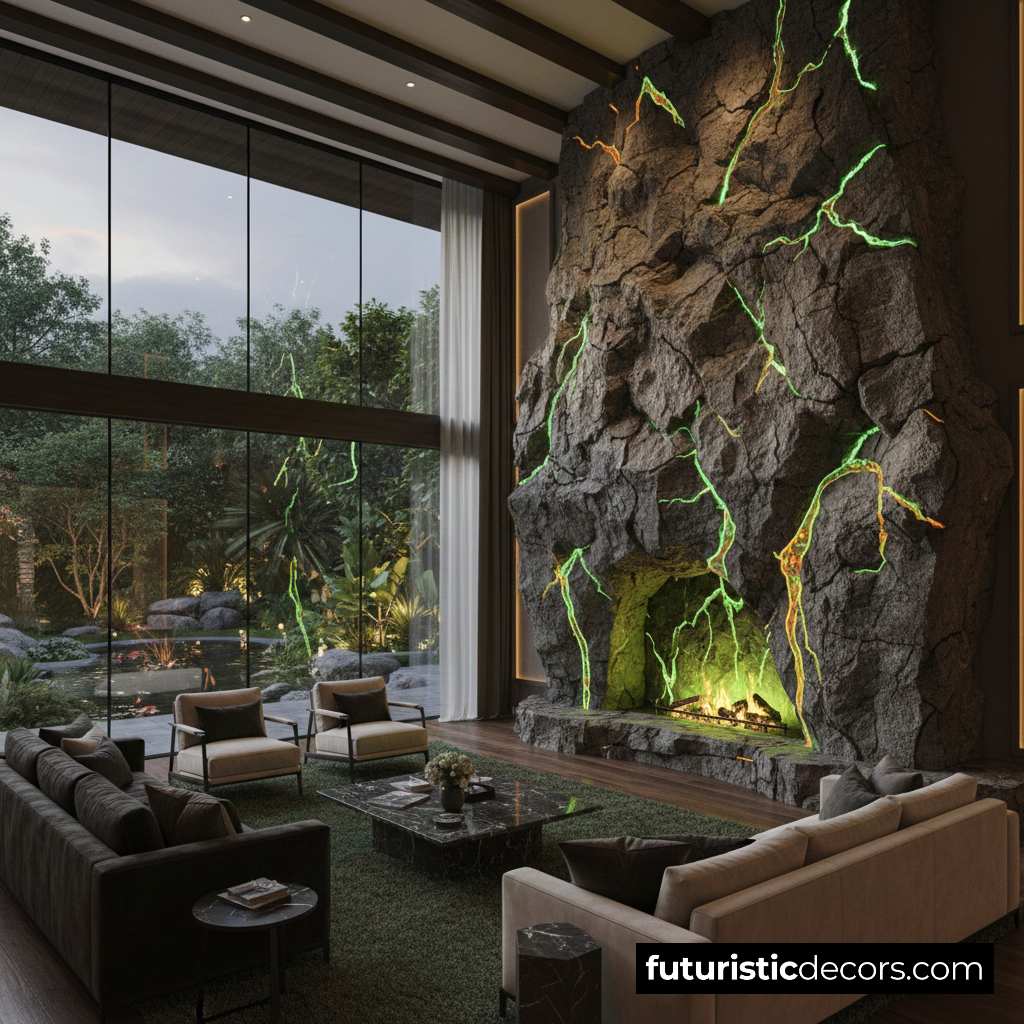Urban living can feel like a perpetual Tetris game: every square foot counts, and every item has to earn its keep. For cat guardians squeezed into studio apartments or slimline condos, the challenge intensifies. You want to give your whiskered roommate a hideaway that feels wild and woodsy—yet you cannot spare half the floor to do it. Enter the Wooden Pallet Cat House, a clever upcycling twist that turns discarded shipping pallets into stylish micro-shelters. Blending sustainability, affordability, and design flexibility, this DIY project delivers genuine creature comfort without crowding out the humans. Over the next several thousand words, we will unpack everything you need to know—from pallet selection and safety prep to creative finishes and maintenance. By the end, you will see why this humble wooden structure has become an urban-pet parenting revelation.
1 Why Choose a Wooden Pallet Cat House for Compact Apartments?
A. Space Efficiency
Pallets typically measure 40 × 48 inches or smaller Euro-sizing variants. By deconstructing and re-cutting the slats, you can craft an enclosure that hugs corners, fits beneath console tables, or even slides inside a deep bookcase cube. Vertical stacking or wall-mount adaptations put previously unused airspace to work.
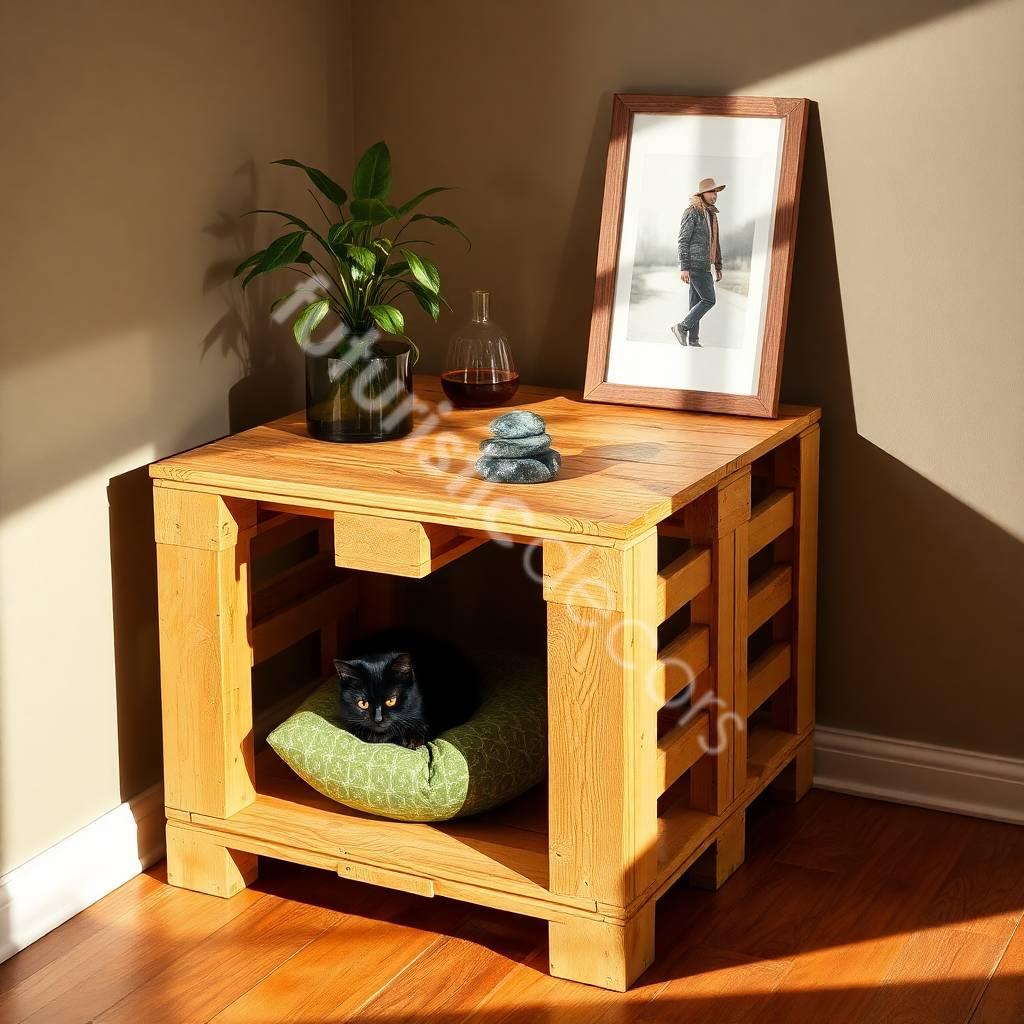
B. Budget-Friendly Brilliance
Upcycled pallets are often free for the asking at hardware stores, garden centers, or local distribution depots. Add a handful of screws, nontoxic wood glue, and a washable cushion, and you can finish the whole build for less than $40—pennies compared to boutique pet pods.
C. Sustainable Storytelling
Each reclaimed board is stamped with the voyage of global trade. When you turn that rough-hewn history into a cozy den, you intercept lumber from the waste stream, slash your carbon paw-print, and give your décor a backstory guests will rave about.
D. Design Adaptability
Because pallets are modular, your Wooden Pallet Cat House can morph to match any aesthetic. Scandinavian blonde? Burned-wood Shou Sugi Ban? Vibrant mural? The raw canvas is yours. Better yet, future tweaks—like adding a planter roof or a scratch-pad wall—require only a driver bit and imagination.
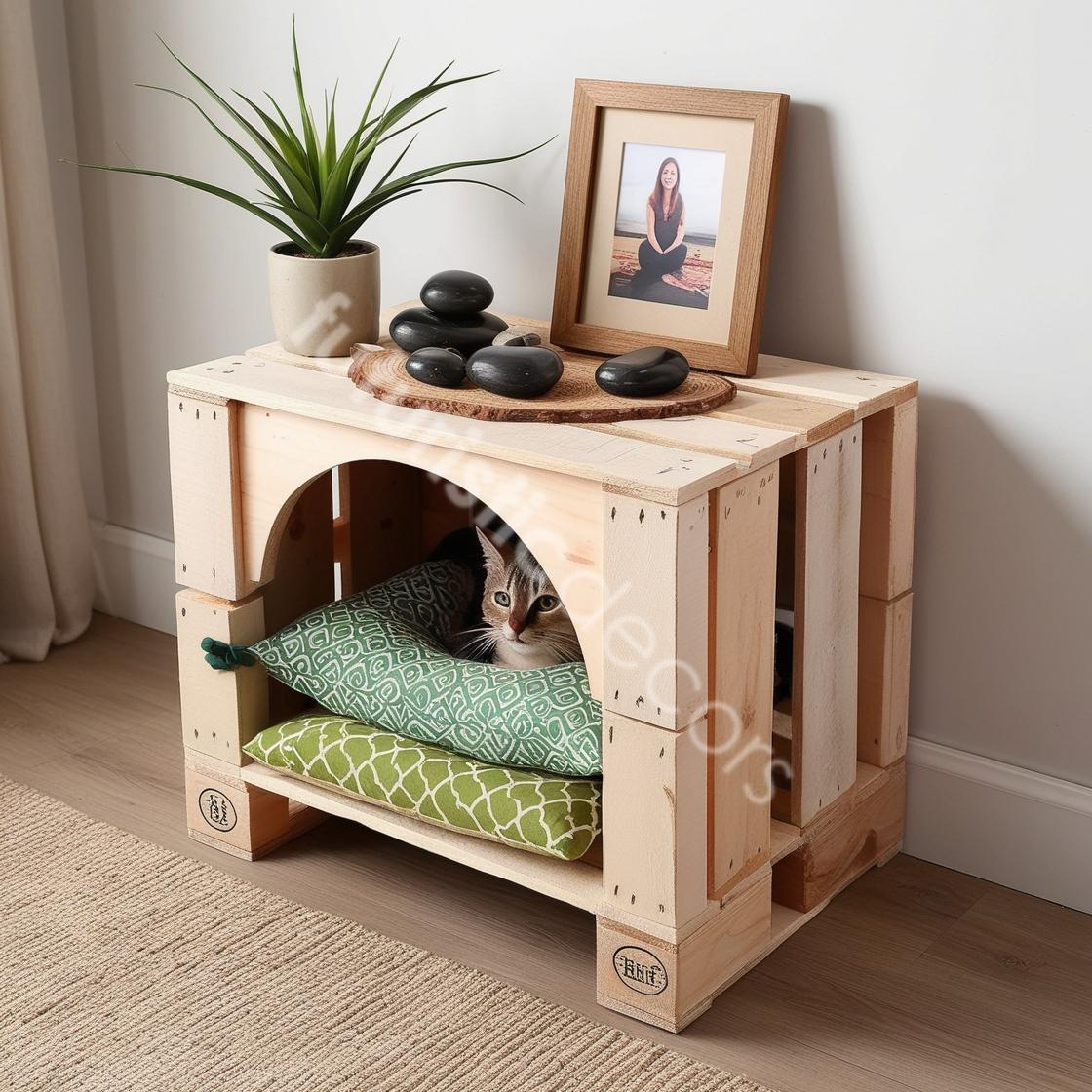
2 Understanding Pallet Wood – Sourcing, Safety, and Sustainability
Before your saw touches timber, you must decode the hieroglyphics branded onto each pallet block.
- HT Mark: Heat-treated, chemical-free, ideal for pet projects.
- KD Mark: Kiln-dried, also safe.
- MB or DB Mark: Methyl bromide or debarked. Avoid MB; it indicates toxic fumigation.
Where to Find Quality Pallets
- Garden Centres & Plant Nurseries – They receive lightweight, non-contaminated stock.
- Small Apparel Boutiques – Clothing pallets rarely bear liquid spills.
- Craigslist / Facebook Marketplace – Search “free pallets,” then verify heat treatment.
Prepping the Lumber
- Inspection: Prise out embedded nails; glide a magnet over the slats for hidden metal fragments.
- Sanding: Start with 80-grit to lift splinters, finish with 120- or 150-grit. Cats adore rubbing cheeks; silky edges prevent accidental cuts.
- Washing & Drying: A 1 : 1 vinegar-water spray wipes out mildew. Let boards sun-dry at least 24 hours.
- Sealing: Apply a pet-safe, water-based polyurethane or beeswax-oil blend. Two thin coats deliver durability without chemical odor.
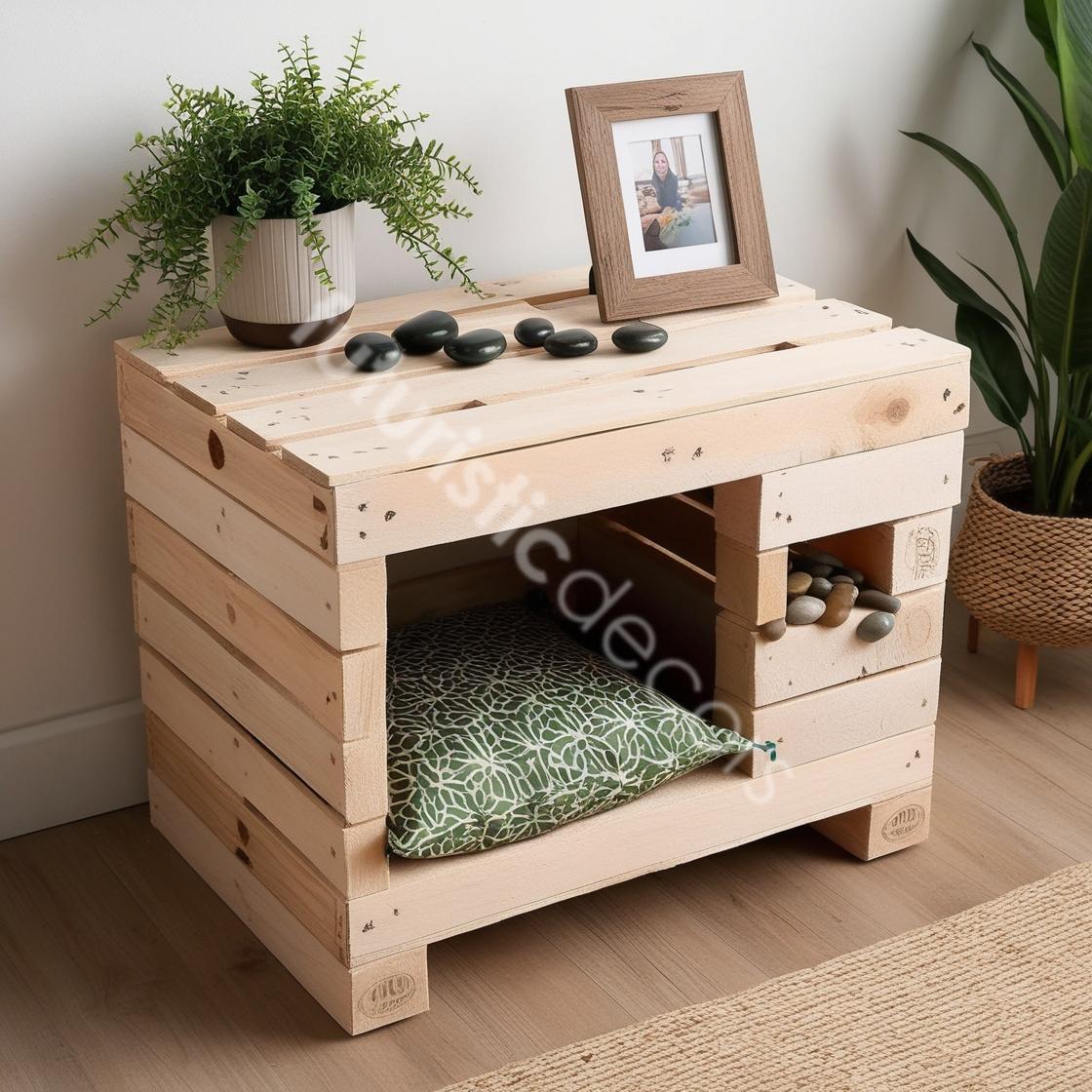
3 Design Principles for Small-Space Cat Housing
Biophilic Comfort: Wooden Pallet Cat House
Cats crave vertical complexity and visual cover. Even a miniature hut feels wilder when you teepee angled slats overhead, creating a shadowy retreat reminiscent of shrub undergrowth.
Traffic Flow: Wooden Pallet Cat House
In tight apartments, humans zigzag daily paths. Place the cat house where paw traffic meets people serendipity—under a windowsill they already patrol or beside your desk’s warm CPU vent—so the feline can lounge and supervise without tripping anyone.
Multi-Function Footprint: Wooden Pallet Cat House
Convert the roof into a side table, a plant perch, or a shoe-drop bench. Every additional function legitimizes the square footage.
Modularity for Growth: Wooden Pallet Cat House
Kittens transform into lanky acrobats before you finish your next rent cycle. Design the Wooden Pallet Cat House with removable end walls or bolt-on annexes, so the dwelling scales up instead of being replaced.
4 Step-by-Step Build Guide: Wooden Pallet Cat House
Tools & Materials Checklist
- Two heat-treated pallets
- Circular saw or handsaw
- Power drill + 1/8-in bit & driver bits
- 1½-in exterior wood screws
- Carpenter’s square & tape measure
- Non-toxic wood glue
- 120-grit sandpaper
- Pet-safe finish
- Cushion insert or memory-foam offcut
- Felt pads (optional)
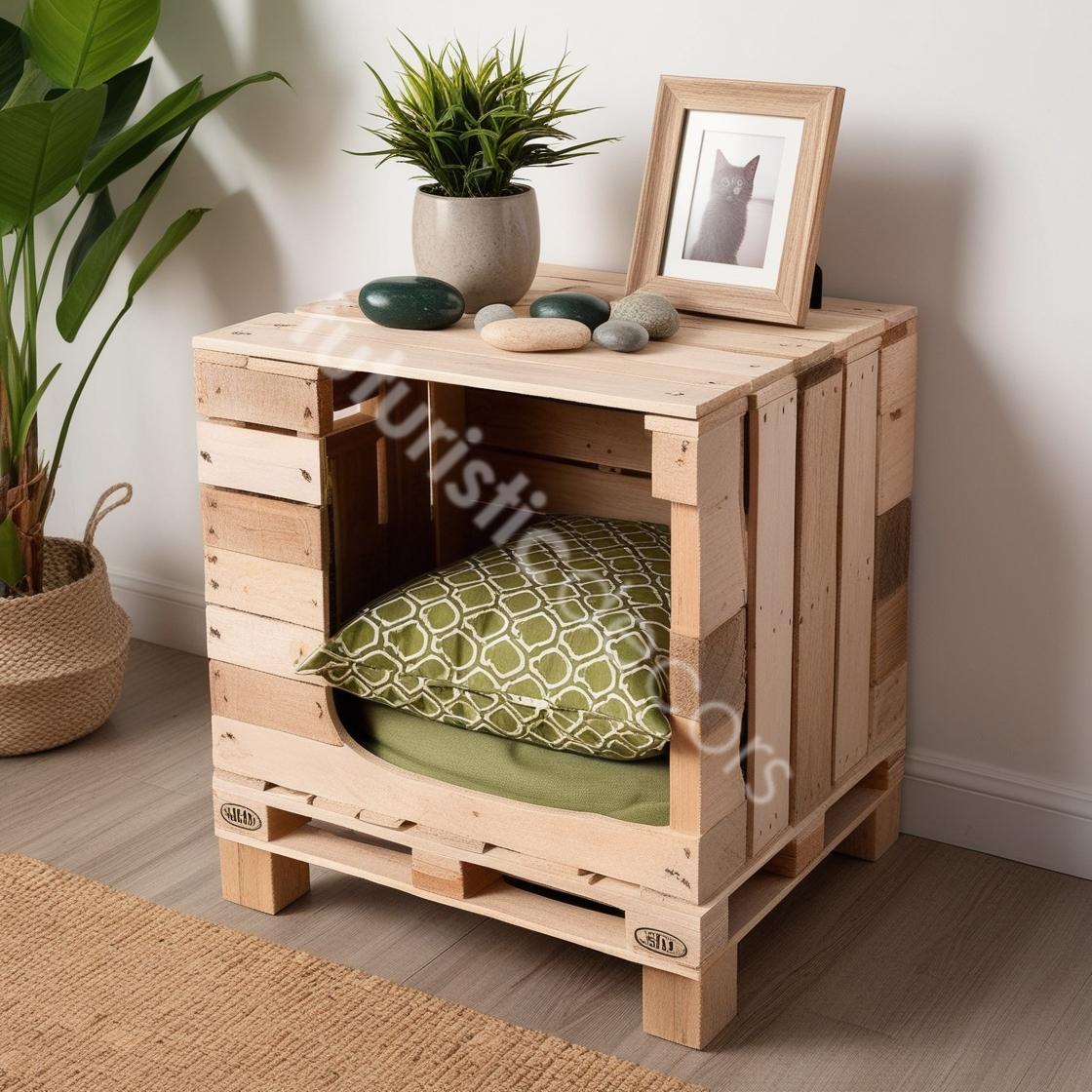
Step 1: Deconstruct the Pallets
Insert a pry bar beneath each deck board, rocking gently to release nails rather than splinter wood. Label boards A (top), B (sides), C (floor) to track lengths.
Step 2: Frame the Base
Cut four A-boards to 24 in. for the short sides and four B-boards to 30 in. for the long sides. Butt-joint them into a rectangle, glue, then screw through pre-drilled pilot holes.
Step 3: Add the Floor
Lay C-boards across the frame. Leave ¼-in gaps for ventilation; cats love a tiny draught in summer. Screw each board twice into the underlying frame.
Step 4: Construct the Walls
Rip-cut four boards to 14 in. height for side walls; repeat for the rear. For the front, leave a 9 in. archway. Use a bowl to trace the arch, jigsaw along the curve, then sand smooth.
Step 5: Roof Assembly
Option A: Flat roof doubles as a side table. Attach boards lengthwise, flush with back wall, overhanging 1 in. up front for rain-style shading.
Option B: A-frame. Bevel-cut edges to 45°, hinge together, then mount on two ledger strips for a cabin vibe.
Step 6: Finish & Furnish
Sand all surfaces until velvety; wipe dust. Apply two sealer coats, letting the first dry four hours. Once cured, drop in a washable cover pillow. Stick felt pads under the floor if your housemates are below you—no thudding paws at 3 a.m.
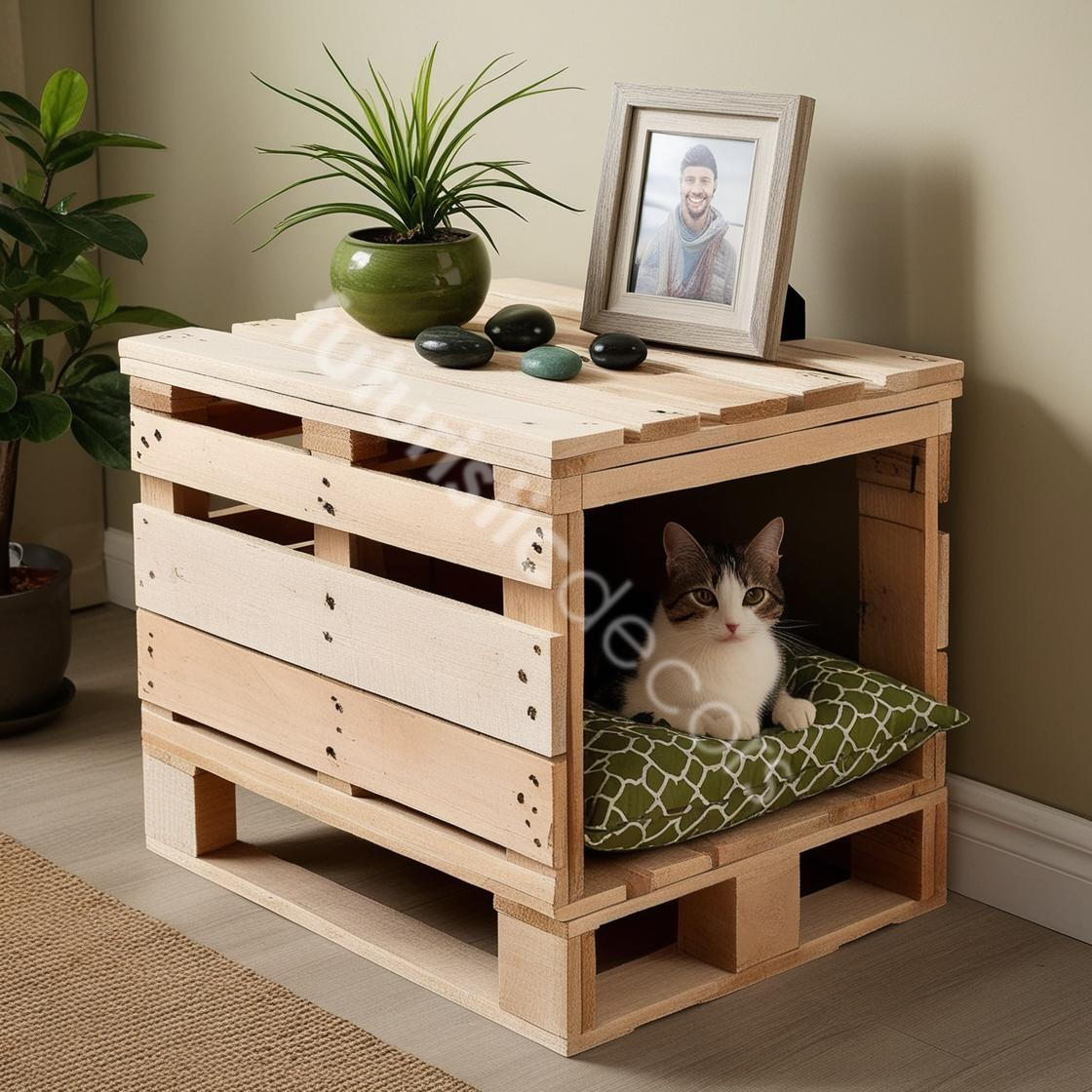
5 Space-Saving Placement Ideas and Apartment Integration
Window Nook Oasis – Slide the cat house flush beneath a sill and mount suction-cup bird feeders outside. Instant feline television.
Entryway Bench Build-Out – Replace a chunky shoe rack with the flat-roof model; stash sneakers inside open cubbies flanking the cat arch.
Under-Desk Refuge – Lift your worktop on risers and nudge the house below; the whir of a laptop fan adds white noise.
Vertical Wall Pod – Use L-brackets to float a reduced-scale version 18 in. above the floor, freeing sweep space underneath.
Balcony Garden Retreat – Seal the exterior with marine varnish, plant cat-safe wheatgrass along the roof edge, and watch your roommate snack alfresco.
6 Styling Your Wooden Pallet Cat House – Finishes, Colors, and Accessories
The Naturalist
Highlight the grain with clear wax. Accent edges with brass corner guards, pair with sisal scratch posts.
The Mid-Century Minimalist
Spray the exterior in matte teak-orange, mask a white door frame, and perch tapered hairpin legs underneath to echo retro credenzas.
The Industrial Loft
Torch burn the boards for a charcoal sheen, then seal. Add powder-coated steel handles on each side for portable panache.
Accessory Add-Ons
- Magnetic Treat Drawer: Hide a tin under the roof; slide out for quick bribes.
- RGB LED Strip: Motion-activated soft glow helps humans avoid stubbing toes at night.
- Planter Box Roof: Grow catnip or trailing ivy; drill drainage holes away from interior seams.
7 Maintenance and Safety Tips: Wooden Pallet Cat House
Weekly Wipe-Down: Use a damp microfiber cloth; avoid bleach.
Quarterly Hardware Check: Tighten screws. Wood expands and contracts with humidity swings common to high-rise HVAC cycles.
Seasonal Finish Recoat: Urban pollution abrades sealants. A fast one-coat refresh each spring preserves wood vibrancy.
Pest Patrol: Elevate the house slightly to deter roaches; cedar chips in a sachet repel fleas.
Cushion Hygiene: Opt for removable covers and machine-wash on gentle using fragrance-free detergent.
8 Budget Breakdown – Cost Comparisons: Wooden Pallet Cat House
| Component | Estimated Cost (USD) | Notes |
|---|---|---|
| Reclaimed pallets | $0–5 each | Often free |
| Screws & glue | $6 | |
| Sandpaper & finish | $9 | Pet-safe water-based |
| Cushion materials | $12 | DIY sewn cover |
| Total | $27–32 | Under boutique alternatives |
Commercial designer cat houses in urban lifestyle catalogs average $149–$289, many of which cannot fold flat or double as furniture. By contrast, your handcrafted Wooden Pallet Cat House slashes expenses by ~80 % while tailoring perfectly to your floorplan.
9 Eco-Friendly Impact and Upcycling Benefits
- Timber Life-Cycle Extension: Each pallet diverted from landfill represents approximately 50 lbs of CO₂ embodied energy saved.
- Zero-New-Plastic: By swapping MDF or acrylic pods for solid wood, you dodge petroleum-derived resins.
- Circular Economy Story: Documenting your build on social media sparks neighbors to rescue more pallets, multiplying ecological dividends.
- Green Roof Potential: Add a shallow tray up top, line with coconut coir, and sow micro-greens—an edible carbon sink above your cat’s head.
Refer to similar product models: Click here
10 Case Studies – City Dwellers Share Success Stories: Wooden Pallet Cat House
Mina & Bean (Brooklyn, 420 sq ft)
Mina transformed a narrow hallway into a “cat runway,” anchoring her pallet house at one end beneath coat hooks. Bean’s anxiety faded; claw marks on the sofa dropped 90 % after the new hideout arrived.
Jorge & Luna (Barcelona, 38 m² Loft)
Jorge elevated the house beside his mezzanine ladder, adding staggered wall steps so Luna leaps upward to her nest. Guests gush over the floating cabin; Instagram reels have topped 50k views.
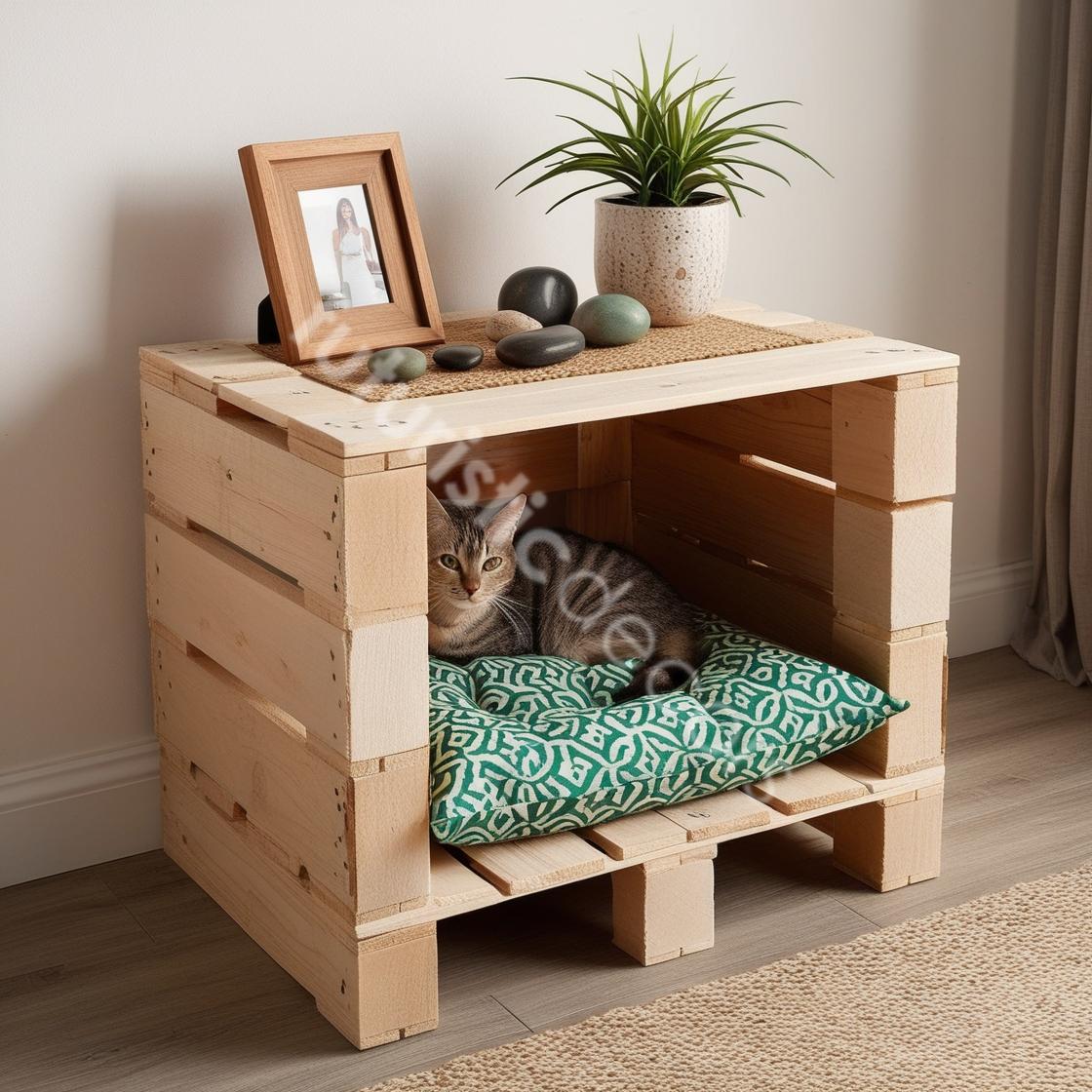
Mai Anh & Michi (Ho Chi Minh City, 25 m² Studio)
With mopeds revving outside, Mai Anh built a double-walled pallet shell, lining the gap with recycled felt for acoustic damping. Michi naps through traffic, while the outer cavity stores notebooks.
11 Troubleshooting Common Issues: Wooden Pallet Cat House
- Splintering During Disassembly: Soak stubborn nail zones with water for five minutes, easing fiber tension before prying.
- Warped Slats: Clamp between two straight boards overnight; slight misting helps coax them true.
- Cat Ignores New House: Rub a soft cloth against your cat’s cheeks, then wipe inside the archway—pheromones declare ownership faster than treats.
- Allergy-Prone Humans: Finish interior surfaces with shellac; its natural resin seals cedar allergen dust.
12 Frequently Asked Questions: Wooden Pallet Cat House
Q1: Is pallet wood strong enough for chunky cats?
Yes. Pallets routinely carry 2,000 lbs. When you reinforce joints with screws and glue, they withstand even Maine Coons vaulting off shelves.
Q2: How long does the build take a novice?
Plan a relaxed weekend: Saturday for deconstruction and sanding, Sunday for assembly and finish. Faster with a friend holding boards square.
Q3: Can I paint vivid colors without harming my pet?
Absolutely—use zero-VOC, water-based paints marketed for nurseries. Cure at least 48 hours before feline occupancy.
Q4: What if I move to a bigger place later?
Because the design uses screws, loosen a few, add extra wall panels, or integrate the unit into a multi-level cat tree.
Q5: Will outdoor balcony placement ruin the wood?
Add marine-grade varnish and elevated plastic feet. Bring cushions indoors during monsoon seasons; the frame itself will shrug off drizzle.
13 Advanced Customizations for Multi-Cat Households
A single Wooden Pallet Cat House can keep one feline blissful, yet many urban pet parents share their home with two, three, or an entire clowder. Scaling the design upward while preserving a modest footprint calls for lateral thinking and clever carpentry hacks. Below are four crowd-pleasing add-ons—each stackable, detachable, and wholly doable inside a weekend.
13.1 The Staggered Duplex
Think of a bunk bed, but fuzzier. Saw the standard pallet footprint in half across its width and assemble two mirror-image dens. Offset the upper module so its entry arch sits diagonal to the lower doorway—that way, cats avoid territorial standoffs. Bolt the units together from the rear stringers and add a slim “spiral” ramp made of cork-backed slats that screw into the sidewall at a gentle 30-degree pitch. The staggered profile tucks neatly in a corner while gifting two private caves—crucial if one cat is shy or senior.
13.2 The Cantilevered Perch
Open-plan loft dwellers often own concrete walls that laugh at nails. Instead, anchor a vertical 2 × 4 cleat into a masonry plug, then lag-bolt a shallow cat house halfway up the wall, allowing the box to float like a minimalist shelf. A second, smaller box mounts 18 inches higher, bridging to the first with a reclaimed skateboard deck wrapped in sisal. The visual weight stays minimal while the living-room footprint remains zero—every inch of floor remains free for your yoga mat or folding dining set.

13.3 Modular Terrace System
For cat guardians blessed with a Juliet balcony, transform the Wooden Pallet Cat House roof into a flip-up hatch. Attach piano hinges along the rear roof edge and secure the front with a butterfly latch. When you open the lid, two telescoping legs pivot down to create a stable micro-terrace, doubling your cat’s sunbathing acreage every morning. A strip of weather-resistant turf inserts atop the lid, turning the pop-up platform into soft summer grass.
13.4 Climbers’ Clubhouse
Maine Coons and Bengals crave vertical conquests. Screw galvanized eye bolts into the cat-house roof, then thread ⅜-inch manila rope upward to ceiling-mounted hooks, finishing the run at a hanging macramé pod. The rope ladder offers a full-body stretch while the suspended pod becomes a lookout. Because the line loads are axial, the slender rope takes up zero floor area, leaving your apartment’s airspace the only frontier.
14 Enrichment Engineering—Turning Shelter into Playground
A comfy retreat is only half the battle; big-city cats must also fend off boredom between feedings. Integrate sensory stimuli directly into the Wooden Pallet Cat House so your pet stays sharp without sprawling toy scatter.
| Enrichment Feature | DIY Method | Feline Benefit |
|---|---|---|
| Crinkle Wall | Sandwich recycled brown paper between two thin pallet slats and screw to an interior panel. | Rewards paw kneading with intriguing sound feedback. |
| Puzzle-Feeder Drawer | Cut a 4 × 12-inch slot in the side, insert a shallow tray with drilled treat holes. | Slows eating, encourages problem-solving. |
| Aromatic Herb Pocket | Staple burlap pouch inside the roof and stuff with dried valerian, chamomile, or organic catnip. | Triggers scent-based exploration, calms anxiety. |
| Light Chaser Port | Mount a solar-powered LED disk beneath translucent roofing; random flickers mimic insect darting. | Promotes stalking behavior without batteries or cords. |
Sprinkle these micro-upgrades sparingly; a sensory buffet quickly morphs into overstimulation. Rotate or swap modules monthly to keep novelty alive.
15 Wellness & Safety—Meeting Feline Health Standards
15.1 Air Quality Matters
Indoor urban air already battles pollutants from traffic exhaust and cooking fumes. Sealant outgassing only compounds the issue. Stick to ultra-low VOC finishes under 30 g/L and cure each coat in a breezy window for at least 48 hours. Slip an activated-carbon sachet beneath the cushion base; it quietly filters dander and micro-odors.
15.2 Temperature Regulation
Pallet wood insulates better than plastic pods, yet heat-island apartments can spike past 86 °F (30 °C) in summer. Drill two 1-inch vent holes high on each sidewall and staple aluminum screen from the inside. In winter, slide cork discs into the vents—cork’s R-value outperforms pine slats inch-for-inch.
15.3 Orthopedic Cushioning
City cats today often live well past 18 years; geriatric joints appreciate memory-foam inserts at least 1½ inches thick. Wrap foam in waterproof PUL fabric before slipping on the decorative cover. Accidents wipe away with a damp cloth, preserving the underlying wood.
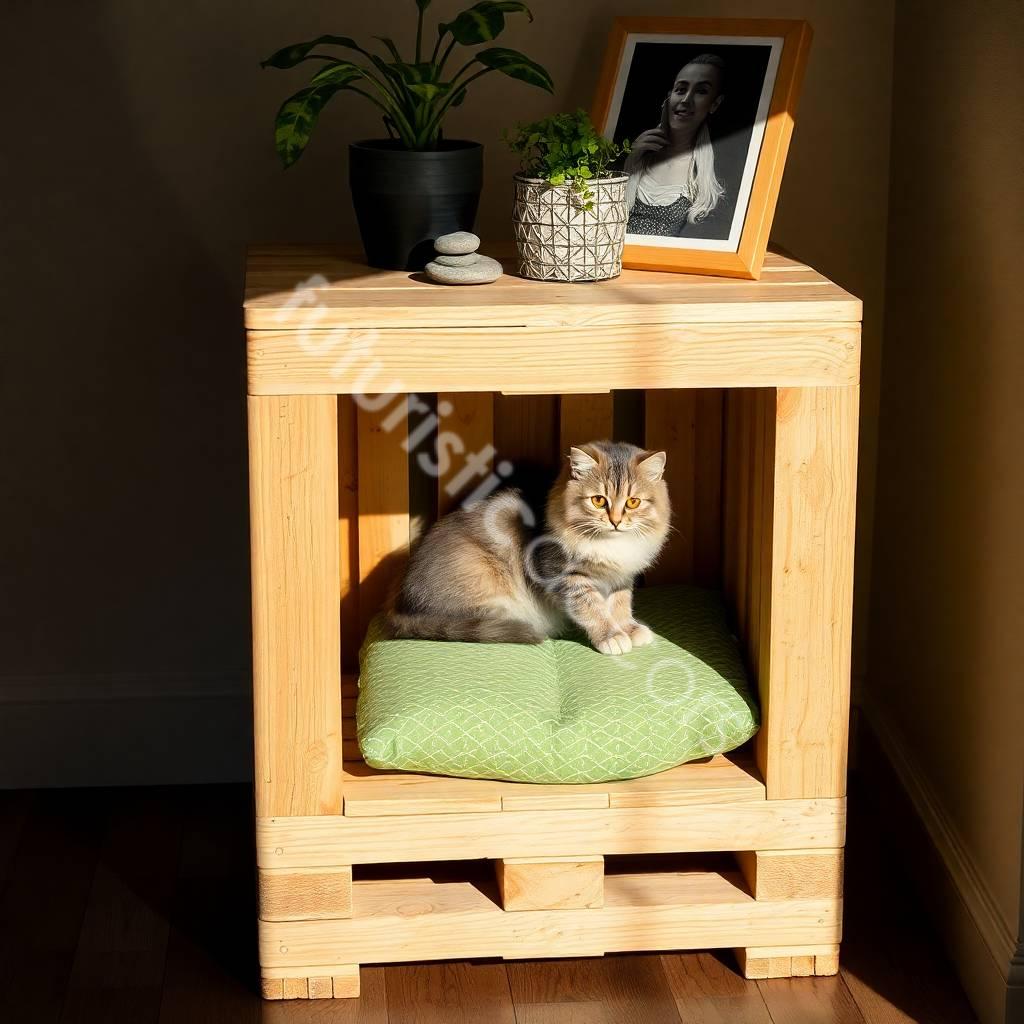
15.4 Anti-Tip Engineering
Tall or wall-mounted builds must survive rambunctious zoomies. Anchor every vertical extension with 3-inch steel L-brackets into wall studs or, where studs are absent, toggle bolts rated 65 lbs or more. A house that wiggles once will never earn the cat’s trust again.
16 Aesthetic Themes to Match Micro-Apartment Styles
Even tiny homes deserve big personality. Here are four trending looks—and exactly how to make your Wooden Pallet Cat House a center-piece rather than an afterthought.
Japandi Calm – Strip slats to bare wood, then stain with diluted walnut ink for a translucent umber wash. Pair with a cream linen cushion, add a single bonsai atop the roof, and embrace negative space.
Post-Modern Pop – Spray prime, then mask geometric blocks in teal, sun-yellow, and hot-pink. Paint the arch interior a contrasting black for a portal illusion. Stick removable terrazzo decals on the roof for cheeky texture.
Urban Jungle – Screw coconut-fiber planters along the sidewall, trail pothos vines downward, and mist weekly. A rattan-wrapped scratch pole on one corner completes the indoor oasis.
Industrial Chic – Rub the surface with vinegar-steel-wool solution to accelerate iron-oxide aging, turning pine to drift-grey. Rivet faux rust sheet-metal plates at the corners, and fit Edison-bulb string lights under the overhang.
Whichever route you pick, repeat one color or material elsewhere in the room—on picture frames, lamp bases, or rugs—so the cat lodge feels intentional, not random.
Conclusion – Crafting Comfort, Celebrating Ingenuity
The Wooden Pallet Cat House is more than a DIY pastime; it embodies a mindful approach to shared urban life. By salvaging forgotten lumber, you create a corner of serenity for your feline while shrinking environmental impact and stretching your budget. With adaptable designs, you can tuck this miniature lodge beneath desks, stack it skyward as art, or slide it onto breezy balconies. Each nail you drive is a statement: small spaces deserve big imagination, and pets deserve dignity no matter the square footage. Whether you’re a first-time pallet wrangler or a seasoned maker, this project invites you to feel the grain beneath your fingers, breathe in the faint pine scent, and watch your cat curl into a hand-built sanctuary—proof that resourcefulness and love can fit inside even the tiniest apartment walls. Happy building, and may every purr echo the pride of crafting something beautiful from what others discard.










